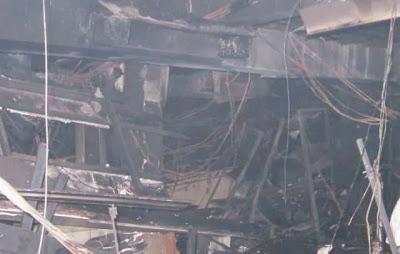What happens or what protects when there is sudden surge / overflow of current………. ..it is known as ‘fuse’ - a type of low resistance resistor that acts as a sacrificial device to provide overcurrent protection, of either the load or source circuit. Primarily it is a metal wire or strip that melts when too much current flows, which interrupts the circuit in which it is connected. Short circuit, overloading, mismatched loads or device failure are the prime reasons for excessive current. Typically, a fuse interrupts excessive current (blows) so that further damage by overheating or fire is prevented. Wiring regulations often define a maximum fuse current rating for particular circuits.
blow a fuse - get very angry and fly into a rage;
the typical example is…. What many Cricket fans underwent in that 48th over against Australia – with James Faulkner batting and Aussies needing 44 off 18 balls, most though match was over…. not Faulkner and Ishant Sharma…. While bowlers ‘reverse-swing’ the ball.. Ishant reverse-swung the match, yielding 30 runs in that awful over and match was won in that over !! ~ the same Ishant is back again bowling in the South Africa onedayers is another point though !!
when we blow a fuse, we criticize strongly and think of possible substitution…. In an electrical circuit, the blown fuse goes away – sacrificing itself saving more valuable equipments….the current that flows in Indian homes is 220 volts….. the current flow should come and get back unhindered …… when you use equipments – they block and utilize electricity which is measured in terms of amperage…. There are some which uses more i.e., draw more amperage.
The wires that carry the current should not get overheated – which can cause an electric fire… so, safety devices are placed. In the distribution boards, there will be fuses which would be designed to withstand a certain amount of amperage – when it increases, the fuse melts – thereby breaking the circuit and stopping further flow of current.
Mostly when we deal with fire claims, the cause of loss is given as ‘short-circuiting’ – most of this attributed due to faulty wires. Though we call every other electrical malfunction as ‘short-circuiting’ – short circuit technically is an electrical circuit that allows a current to travel along an unintended path, often where essentially no (or a very low) electrical impedance is encountered.

Short circuit is simply a low resistance connection between the two conductors supplying electrical power to any circuit. A short circuit may be in a direct- or alternating-current (DC or AC) circuit. If it is a battery that is shorted, the battery will be discharged very quickly and will heat up due to the high current flow. Short circuits can produce very high temperatures due to the high power dissipation in the circuit. If a charged, high-voltage capacitor is short circuited by a thin wire, the resulting huge current and power dissipation will cause the wire to actually explode.
A couple of years back in Oct 2011 – there was ‘Operation Short Circuit’ in US conducted by U.S. Immigration and Customs Enforcement – it was to protect consumers from counterfeit electrical goods. The circular issued by the Department stated that a three-month operation conducted by 43 countries resulted in the seizure of more than one million counterfeit electrical goods. This operation was spearheaded in the United States by the National Intellectual Property Rights Coordination Center (IPR Center), in coordination with the World Customs Organization (WCO).
"Counterfeit products threaten the health, safety and security of Americans," said U.S. Immigration and Customs Enforcement (ICE) Director. "Counterfeit electrical articles are particularly troubling, as these illicit products represent a significant threat to public safety as they do not adhere to any standards for testing, quality or operation." Eighty seizures in the United States resulted in the seizure of: • 2,706 boxes of counterfeit holiday lights; • 2,015 boxes of counterfeit extension cords; • 24,579 counterfeit batteries; • 21,979 counterfeit power supplies; • 30,863 counterfeit power adapters, and • 57,662 counterfeit power chargers. All the items seized for being in violation of U.S. law - trafficking in counterfeit goods. The estimated manufacturer's suggested retail price (MSRP) of these items is $5.8 million. Worldwide, 43 countries discovered 10,272 shipments. The participating nations detained 1,747 shipments and seized 388 shipments. Counterfeit goods represent a triple threat by delivering shoddy, and sometimes dangerous, goods into commerce, by funding organized criminal activities and by denying Americans good-paying jobs," added ICE Director Morton.
Blissfully ignorant of everything, many of us buy cheap spurious goods including electric bulbs – which can cause immeasurable harm….. from next time, buy only tested brands – never compromise and buy a cheap product sold in black market as Chinese / Taiwanese product which carry no guarantee.
With regards – S. Sampathkumar.
13.12.2013

